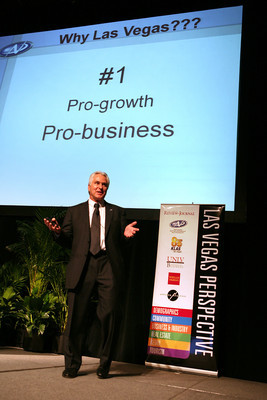Officials address valley’s issues
Even in these troubled economic times, Las Vegas is not a bad place to live, one of the city's top promoters said Thursday at Las Vegas Perspective, a forum sponsored partly by the Las Vegas Review-Journal.
Somer Hollingsworth, president of the Nevada Development Authority, said Las Vegas remains the city of the 21st century and, though population growth has slowed, people continue to move here. With only 3.2 percent native population, the lowest in the nation, Las Vegas is a melting pot of people from other places. About a third of valley residents came from California.
Last year, about 78,000 new residents moved to Las Vegas, a 9 percent decline from 85,000 newcomers in 1997, Hollingsworth noted. Nevertheless, the valley's population has increased 68 percent in the last 10 years to more than 2 million.
"Think about where you're from, where you'd like to move and why you should stay here," Hollingsworth told about 750 businesspeople at the Rio. "What happens here is so business-friendly compared to other states, you can't believe it. It's like a dream state."
Hollingsworth showed a series of advertisements featuring the "tax bear" that ran in California, encouraging companies to leave the Golden State for Nevada.
Among the "Sweet 16" reasons why Las Vegas has and will continue to flourish, Hollingsworth said, are its lack of a corporate income tax, its best-in-the-nation economic growth and that it is part of a foreign trade zone.
It is also home to the Nevada Cancer Institute, and soon the Lou Ruvo Brain Institute and UNLV Harry Reid Research and Technology Park.
"Everybody said smart people won't move here," Hollingsworth said as he listed some of the doctors at the Nevada Cancer Institute and their qualifications. "Well, they did."
Playing off the "Charting the Course" theme at Perspective, Jeremy Aguero of Applied Analysis, a Las Vegas financial consultancy, said you first have to "understand the terrain." Right now, it's a little rough in Las Vegas, he said.
Over the past 12 months, key economic indicators such as population growth, taxable spending and new housing permits have declined while the unemployment rate has risen, Aguero noted. Visitor volume and total employment have shown modest gains.
"We're addicted to growth and we're failing to keep up with it," he said. "We're a community with one foot firmly planted in the 1980s when we were a small community and another foot striving to get over the 2 million (population) mark. Those are competing interests."
An insufficient transportation network and diminishing water supply are the biggest risks facing Las Vegas, Aguero said. He predicted double-digit declines in land prices this year and instability in the commercial markets next year with vacancies continuing to rise.
By 2010, when Las Vegas adds anywhere from 40,000 to 100,000 new jobs, there will be a lack of work-force housing, Aguero said.
"There are communities from the East Coast to the West Coast that would give an eyetooth to have our problems," he said. "CityCenter, Fontainebleau, Echelon -- these aren't pie in the sky. They all represent multibillion-dollar projects."
Gov. Jim Gibbons said Southern Nevada must decrease its dependence on the Colorado River as the sole source of water to ensure the region's vitality in the long run.
The state reallocated $1 billion necessary for highway improvements without raising taxes, but it's far from sufficient capital for all the needed future infrastructure work, he said.
Nevada also needs to restore public faith in health care, Gibbons said.
"Mistakes by a few put thousands of Southern Nevadans at risk and caused hundreds of thousands to question the quality of our health care system."
Contact reporter Hubble Smith at hsmith@reviewjournal.com or (702) 383-0491.

















